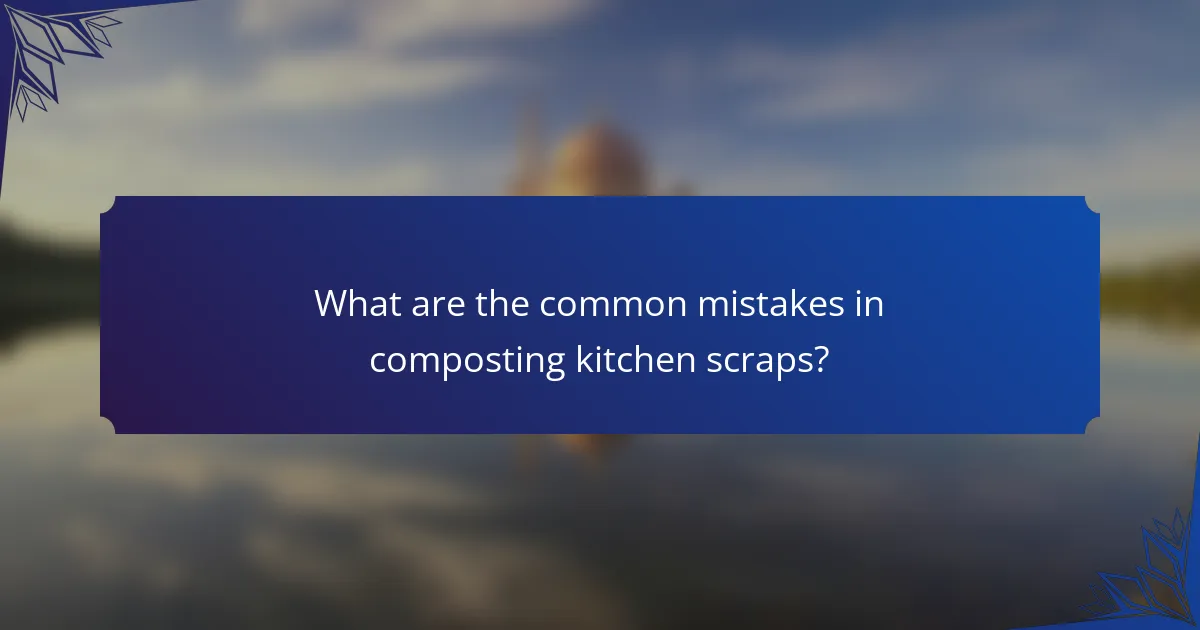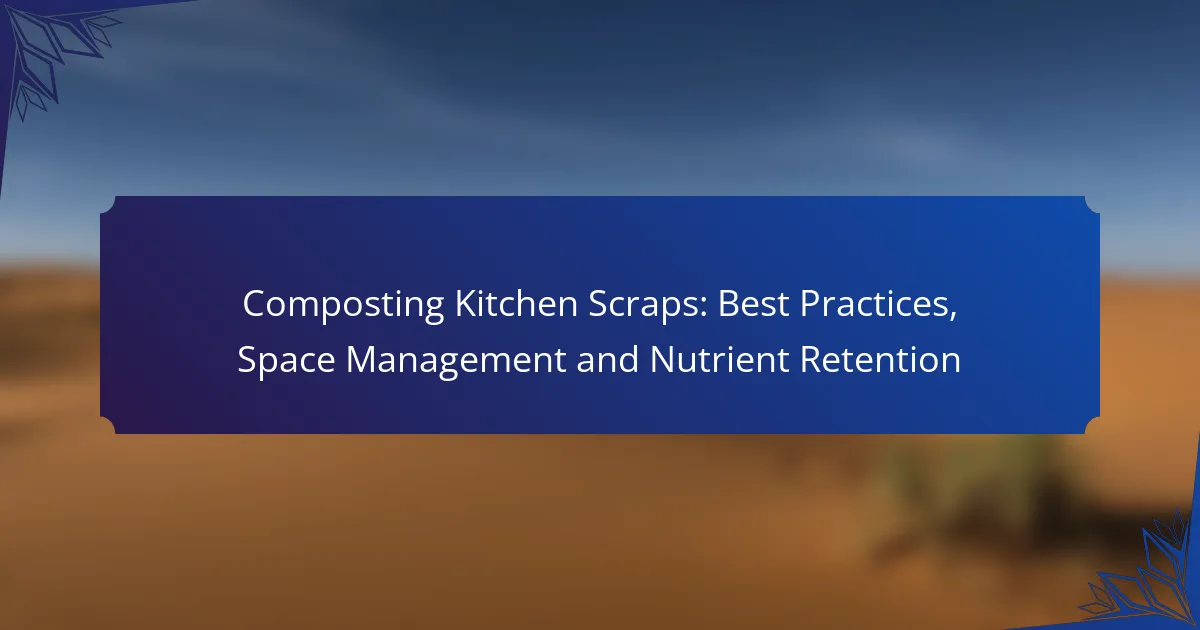Composting kitchen scraps is a sustainable way to reduce waste and enrich your garden soil. By balancing green and brown materials, maintaining proper moisture, and turning your compost regularly, you can create nutrient-rich compost that benefits plant growth. Efficient space management is key in small kitchens, where compact composting solutions can help you make the most of limited areas while ensuring effective decomposition.

How to compost kitchen scraps effectively?
Composting kitchen scraps effectively involves balancing green and brown materials, maintaining moisture, and regularly turning the compost. By following these best practices, you can create nutrient-rich compost that enhances soil health.
Layering green and brown materials
Layering green and brown materials is crucial for successful composting. Green materials, such as fruit and vegetable scraps, provide nitrogen, while brown materials, like dried leaves and cardboard, supply carbon. A common ratio is about 2 parts brown to 1 part green.
Mixing these materials helps create a balanced compost pile that decomposes efficiently. Avoid adding too many greens at once, as this can lead to odor issues and slow decomposition.
Maintaining moisture levels
Moisture is vital for composting, as it helps microorganisms break down organic matter. Aim for a moisture level similar to a damp sponge; if the compost feels too dry, add water or more green materials.
Conversely, if the compost is too wet, it can become compacted and smelly. In such cases, add more brown materials to absorb excess moisture and aerate the pile.
Turning the compost regularly
Turning the compost regularly, ideally every few weeks, aerates the pile and speeds up decomposition. This process introduces oxygen, which is essential for aerobic bacteria that break down organic matter.
Use a pitchfork or shovel to mix the materials, ensuring that the outer layers are moved to the center. This helps maintain an even temperature and promotes uniform decomposition.
Using a compost bin or pile
Choosing between a compost bin or a pile depends on your space and preferences. A compost bin can help contain odors and pests, while a pile is more accessible for larger quantities of scraps.
For bins, ensure they have adequate ventilation and drainage. If using a pile, keep it at least 3 feet wide and tall to maintain heat and moisture levels effectively.
Monitoring temperature
Monitoring the temperature of your compost is essential for ensuring proper decomposition. The ideal temperature range is between 130°F and 160°F (54°C to 71°C), which indicates active microbial activity.
Use a compost thermometer to check the temperature regularly. If it falls below 130°F, consider turning the pile or adding more green materials to boost microbial activity.

What kitchen scraps are best for composting?
The best kitchen scraps for composting include organic materials that break down easily and provide essential nutrients to the compost. Common items like fruit and vegetable peels, coffee grounds, eggshells, and grains contribute to a rich compost mix.
Fruit and vegetable peels
Fruit and vegetable peels are excellent for composting as they are rich in nitrogen and break down quickly. Items like potato skins, carrot tops, and apple cores can add valuable nutrients to your compost pile.
When composting peels, avoid those that are heavily waxed or treated with pesticides, as they may introduce harmful chemicals into your compost. Aim for a balanced mix of green (nitrogen-rich) and brown (carbon-rich) materials for optimal decomposition.
Coffee grounds and filters
Coffee grounds and filters are a fantastic addition to compost due to their high nitrogen content. Used coffee grounds can make up about 20% of your compost pile, providing essential nutrients while improving soil structure.
Ensure that you mix coffee grounds with other materials to prevent clumping, which can slow down decomposition. If you use paper filters, they are compostable as well, but avoid those with synthetic fibers.
Eggshells
Eggshells are a great source of calcium, which is vital for plant health. Crushing the shells before adding them to your compost helps speed up their breakdown and makes the calcium more accessible to plants.
While eggshells can be composted, they should not make up a large portion of your compost. A handful of crushed shells per batch is sufficient to provide the necessary nutrients without overwhelming the mix.
Grains and bread
Grains and bread can be composted, but they should be added in moderation. These materials can attract pests if not properly managed, so it’s best to bury them within the compost pile.
When composting grains, avoid those that are moldy or spoiled, as they can introduce unwanted bacteria. Stick to small amounts to maintain a balanced compost and ensure effective decomposition.

How to manage composting space in small kitchens?
Managing composting space in small kitchens requires efficient use of limited areas while ensuring effective decomposition. Utilizing compact composting solutions can help maximize space and maintain a clean environment.
Using countertop compost bins
Countertop compost bins are ideal for small kitchens as they take up minimal space and provide easy access for collecting kitchen scraps. Look for bins with tight-fitting lids to minimize odors and pests.
When selecting a countertop bin, consider materials like stainless steel or BPA-free plastic for durability. Many models come with charcoal filters to further reduce smells, making them suitable for indoor use.
Implementing vermicomposting
Vermicomposting involves using worms to break down organic waste, making it a compact and efficient method for small kitchens. A worm bin can fit under a sink or in a cupboard, allowing for discreet composting.
To start vermicomposting, choose a bin with proper ventilation and drainage. Red wigglers are the most common worms used, and they thrive on kitchen scraps like fruit peels and vegetable trimmings. Ensure the bin remains moist but not overly wet to keep the worms healthy.
Utilizing outdoor compost tumblers
If space allows, outdoor compost tumblers can be a great addition to small kitchens, providing a larger capacity for composting. These enclosed systems accelerate decomposition and are less prone to pests compared to traditional piles.
When using a tumbler, regularly rotate it to mix the contents and speed up the composting process. Aim for a balance of green materials (like food scraps) and brown materials (like dried leaves) to maintain optimal conditions for composting. Ensure the tumbler is placed in a convenient location for easy access from the kitchen.

What are the benefits of composting kitchen scraps?
Composting kitchen scraps offers numerous advantages, including reducing waste sent to landfills and enriching soil health. By transforming organic waste into nutrient-rich compost, you can support sustainable gardening and farming practices.
Reducing landfill waste
Composting kitchen scraps significantly decreases the volume of waste that ends up in landfills. Organic materials, such as fruit peels and vegetable trimmings, make up a substantial portion of municipal solid waste. By composting these items, you can divert them from landfills, reducing greenhouse gas emissions and prolonging landfill lifespan.
To effectively reduce landfill waste, consider setting up a compost bin in your backyard or using a countertop compost container. Many municipalities offer composting programs that can help you manage your kitchen scraps efficiently.
Improving soil health
Composting kitchen scraps enhances soil health by adding organic matter and beneficial microorganisms. This process improves soil structure, increases water retention, and promotes nutrient availability for plants. Healthy soil is essential for robust plant growth and can lead to higher crop yields.
Incorporate compost into your garden by mixing it with existing soil or using it as a top dressing. Aim for a compost-to-soil ratio of about 1:3 for optimal results. Regularly adding compost can transform poor soil into a fertile growing medium.
Enhancing nutrient retention
Composting kitchen scraps helps retain essential nutrients in the soil, making them more accessible to plants. Nutrients like nitrogen, phosphorus, and potassium are vital for plant growth, and compost acts as a slow-release fertilizer, providing these elements over time.
To maximize nutrient retention, ensure your compost pile has a balanced mix of green materials (like vegetable scraps) and brown materials (like dried leaves). This balance promotes efficient decomposition and nutrient cycling, benefiting your garden and reducing the need for chemical fertilizers.

What are the common mistakes in composting kitchen scraps?
Common mistakes in composting kitchen scraps can hinder the decomposition process and affect the quality of the compost. Understanding these errors helps ensure a successful composting experience.
Adding meat and dairy products
Including meat and dairy in compost can attract pests and produce unpleasant odors. These items break down slowly and can create an unhealthy environment for beneficial microorganisms.
To avoid these issues, stick to plant-based scraps like vegetable peels, fruit cores, and coffee grounds. If you want to compost animal products, consider using a specialized composting system designed for that purpose.
Neglecting to aerate the compost
Failing to aerate compost can lead to anaerobic conditions, resulting in foul smells and slow decomposition. Regularly turning the compost pile introduces oxygen, which is essential for the microorganisms that break down organic matter.
Aerate your compost every few weeks by turning it with a pitchfork or shovel. This practice not only speeds up the composting process but also helps maintain a balanced moisture level.
Overloading with one type of material
Overloading your compost with a single type of material, such as only fruit scraps or only leaves, can create an imbalance in nutrients. A diverse mix of green materials (nitrogen-rich) and brown materials (carbon-rich) is crucial for effective composting.
A good rule of thumb is to maintain a ratio of about 2:1 brown to green materials. This balance promotes healthy microbial activity and results in nutrient-rich compost.
